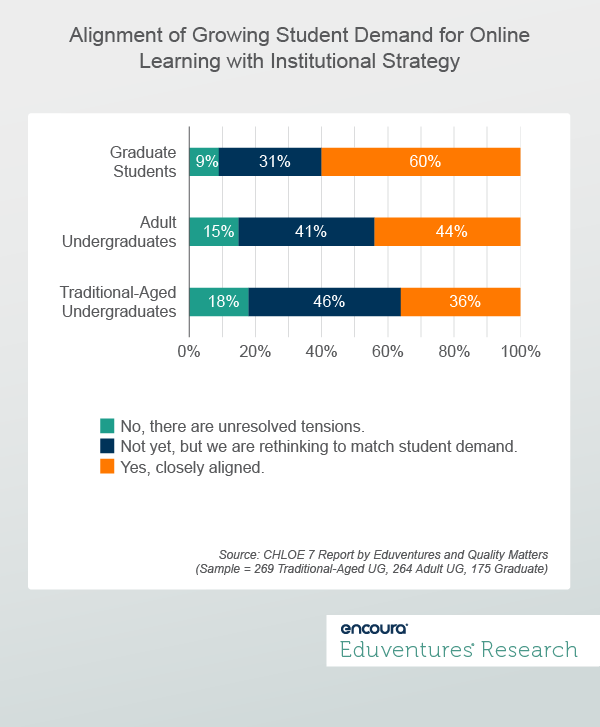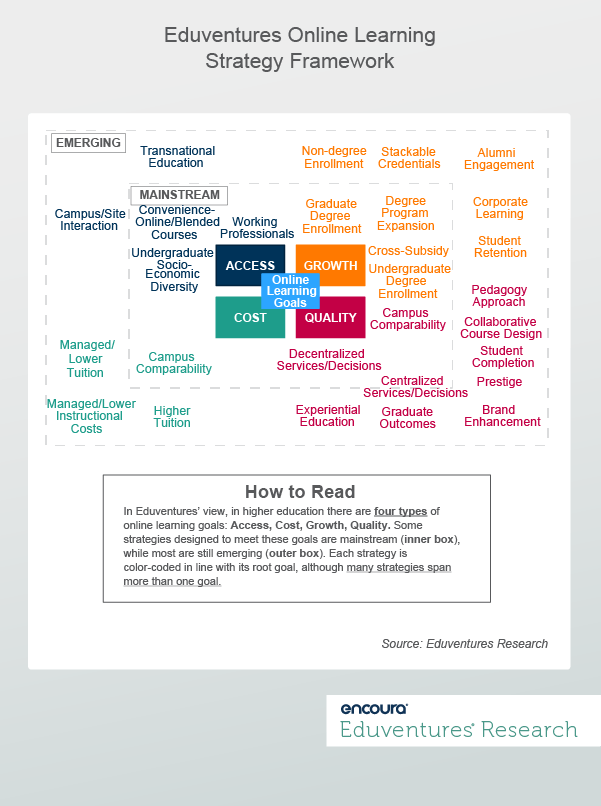June 14-16, 2023
Boston, MA
Historically, online strategy has happened at the course or program level—often reduced to putting campus-based programs online to reach more students and counteract struggling enrollments. But today the line between online and on-campus students is blurring. The assumption that these modalities appeal to entirely separate audiences may soon become outdated.
New research from the Eduventures Prospective Student Research™ Survey reveals that the percentage of high school juniors and seniors planning to attend fully online colleges has more than doubled compared to pre-pandemic levels. While the absolute numbers are small, online is a growing option for these students.
Mixed Messages About Online Preference
Let's start by acknowledging some conflicting evidence about online preferences among traditional undergraduates. We know that many traditional undergraduates experienced subpar remote learning in high school and started this school year eager for a campus-based experience. Two-thirds of traditional-aged prospective students were expecting to take fully on-campus courses, according to the Eduventures 2022 Prospective Student Survey.
A recent EDUCAUSE survey of current undergraduate students reported that just 41% wanted courses either fully or mostly face-to-face, while 29% wanted their courses either fully or mostly online. Students valued online courses for allowing them to meet personal needs outside of school, and campus courses for allowing them to make social connections.
Perhaps post-pandemic students simply want it all: They want the flexibility of online learning when it meets their personal needs but find they connect better with faculty and other students in-person. Institutions will not be able to provide a “goldilocks” version to every student, but some chief online officers (COOs)—our inclusive term for online learning leaders at institutions—are exploring ways to accommodate this shifting demand.
Institutional Strategy Alignment with Growing Online Demand
In the CHLOE 7 study (Changing Landscape of Online Learning), we asked COOs to gauge the relative alignment between growing student online interest and institutional strategies, investments, and operations (Figure 1). Most online leaders painted a rosy picture of strategic alignment compared to expected demand, with a majority reporting they are either closely aligned or working toward alignment for all student populations.

These leaders, however, also recognized the biggest gap in alignment is among traditional-aged undergraduates. Just 36% reported close alignment between strategy and demand. The majority cited unresolved tensions or a rethinking of their strategy alignments with this cohort.
This is another indication that COOs have seen the pandemic accelerate anticipated trends and drive institutional investment in online learning. How are institutions taking action?
Four Pillars of Online Learning Goals
When it comes to online learning, forward-thinking institutions are thinking beyond enrollment growth. Eduventures finds that online strategies fall under four broad goals: growth, access, cost, and quality (see Figure 2).
Some strategies are mainstream (inner box) while others are emerging (outer box), which can depend on institutional size and type. This Online Learning Strategy Framework can allow institutions to evaluate new or existing goals comprehensively and to benchmark themselves against peers.

In Figure 2, online learning strategies are color-coded with their associated root goals. Some of these strategies span multiple goals as they are not discrete but complementary and interdependent.
Below, we outline these four goals and provide example questions intended to promote internal discussions. These questions are designed for an institution that focuses on traditional undergraduates but has some students interested in online enrollment and some wanting to be intentional with an online strategy:
- Growth. This is the most heavily prioritized online learning goal where institutions want net-new online learners to bolster their overall enrollments:
- How can online modality increase campus student retention with limited capacity and budget?
- Which programs should we invest and/or divest in as we look at changing student preferences?
- Access. Ensuring educational opportunities for all students regardless of demographic factors can include evaluating support for existing students or new student groups that institutions may be underserving:
- How can our institution support working professional students and those who have not had traditional pathways to higher education?
- Are students who enroll online more or less diverse than our whole student population?
- Cost. The reduction in spending across instruction and support services can also include goals to alleviate high tuition, out-of-pocket expenses, and debt for students:
- Should there be a price differential between online and campus-based programs?
- Are there savings with online course replacement of campus-based courses, instead of running the same course with multiple modalities?
- Quality. This goal represents the comprehensiveness of student support, online course pedagogy, and measuring student outcomes and can also include maintaining quality with scale:
- How do learning outcomes compare between students with different program modalities?
- Can innovative online pedagogy improve the student experience and affect outcomes?
The Bottom Line
When it comes to online learning in 2023, one size does not fit all. To date, most online strategy has happened at the program and course levels. But online learning is now a mature market. Fully online programming has become competitive, making it harder for these programs to differentiate.
We see a clear growing preference for online learning across student populations. What was once relegated to adult undergraduate and graduate students has become mainstream. Institutions should take the opportunity to chart their courses, informed by their missions, capacities, budget situations, and historical student populations served.
Admittedly, this is no easy task.
Challenges abound—from stakeholder alignment to deciding where to focus. Evaluating each area of growth, access, cost, and quality is key to developing an institutional online identity that makes online modality more than just an additive revenue source. This holistic and strategic approach can allow institutions to weigh trade-offs, make proper investments, meet institutional goals, provide the best possible educational experiences, and to clearly communicate those experiences.
Ultimately, thoughtful institution-wide online learning goals and strategies can advance and augment key institutional benchmarks while enjoying enrollment growth as a bonus.
Never Miss Your Wake-Up Call
Learn more about our team of expert research analysts here.
Eduventures Senior Analyst at Encoura
Contact
This recruitment cycle challenged the creativity of enrollment teams as they were forced to recreate the entire enrollment experience online. The challenge for this spring will be getting proximate to admitted students by replicating new-found practices to increase yield through the summer’s extended enrollment cycle.
By participating in the Eduventures Admitted Student Research, your office will gain actionable insights on:
- Nationwide benchmarks for yield outcomes
- Changes in the decision-making behaviors of incoming freshmen that impact recruiting
- Gaps between how your institution was perceived and your actual institution identity
- Regional and national competitive shifts in the wake of the post-COVID-19 environment
- Competitiveness of your updated financial aid model

